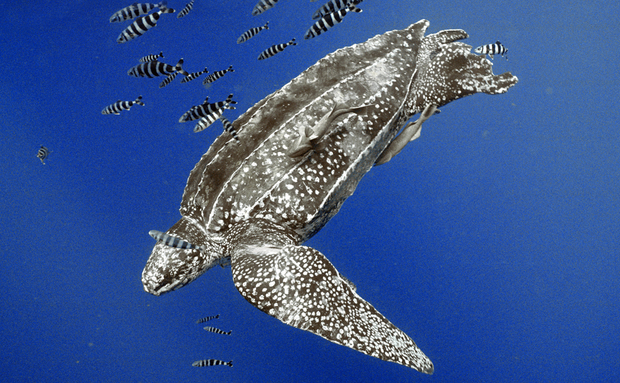TARTARUGA DE COURO – LEATHERBACK SEA TURTLE – Dermochelys coriacea
A tartarugas de couro são as maiores tartarugas na Terra, crescendo até dois metros de comprimento e pesam mais de 900 kg. Estas relíquias reptilianos são os representantes únicos remanescentes de uma família de tartarugas que possui as suas raízes evolutivas de volta mais de 100 milhões de anos. Uma vez que prevalece em todos os oceanos, exceto o Ártico e na Antártida, a população de couro está diminuindo rapidamente em muitas partes do mundo.
Enquanto todas as outras tartarugas marinhas têm rígidos, conchas ósseas, a carapaça de tinta azul-do-couro é um pouco flexível e quase elástico ao toque. Cumes ao longo da carapaça dar-lhe uma estrutura mais hidrodinâmico. A tartaruga de couro pode mergulhar a profundidades de 1.280 metros, mais fundo que qualquer outra tartaruga e pode ficar embaixo d’água por até 85 minutos.
Leatherbacks ter a mais ampla distribuição global de todas as espécies de répteis, e, possivelmente, de qualquer vertebrado. Eles podem ser encontrados no trópico e águas temperadas do Atlântico, Pacífico e Índico, bem como o Mar Mediterrâneo. Esta espécie adulta também atravessar para o norte até o Canadá e a Noruega e até o sul de Nova Zelândia e América do Sul. Ao contrário de seus parentes répteis, tartarugas são capazes de manter a temperatura do corpo quente em água fria usando um único conjunto de adaptações que lhes permite tanto gerar e reter o calor do corpo. Estas adaptações incluem o grande tamanho do corpo, alterações na atividade de natação e fluxo de sangue, e uma camada espessa de gordura.
Leatherbacks podem realizar as migrações mais longas entre áreas de reprodução e de qualquer tartaruga marinha alimentação, com média de 6.000 Km em cada sentido. Após o acasalamento no mar, as fêmeas vêm em terra para fazer o após a estação de monta . O ritual é noturno e envolve a escavação de um buraco na areia, depositando em torno de 80 ovos, enchendo o ninho, deixando uma grande área remexida de areia que faz a camuflagem para despistar os predadores e, finalmente, retornando para o mar.
A temperatura no interior do ninho determina o sexo das crias. Uma mistura de crias machos e fêmeas ocorre quando a temperatura do ninho é aproximadamente de 29,5 graus Celsius, enquanto que as temperaturas mais elevadas produzem fêmeas e temperaturas mais baixas produzem machos. Filhotes fêmeas que vão para o mar vagueiam os oceanos até atingirem a maturidade sexual, quando eles retornam para as mesmas áreas de nidificação para produzir sua própria prole. Os machos passam o resto de suas vidas no mar.
Sua vida útil é desconhecida, mas muitas tartarugas de couro tem um fim precoce devido à atividade humana. Estima-se que apenas cerca de uma em cada mil filhotes de couro sobreviver até a idade adulta. Os ovos são muitas vezes tomadas por seres humanos a partir de ninhos de ser consumido para subsistência ou como afrodisíacos. Muitas tartarugas são vítimas de linhas e redes de pesca, ou são atingidas por barcos. Leatherbacks também pode morrer se ingerem flutuante de detritos de plástico confundido com a sua comida favorita: água-viva. Alguns indivíduos foram encontrados para ter quase 5 kg de plástico em seus estômagos.
Leatherbacks estão atualmente designadas como ameaçadas de extinção nos termos da Lei das Espécies Ameaçadas dos Estados Unidos. O número de tartarugas no Atlântico parece estar estável ou aumentar, mas a população do Pacífico está a diminuir a um ritmo alarmante, devido à colheita de ovos, pesca pesca acidental, o desenvolvimento costeiro e disponibilidade de alimentos altamente variável. Algumas populações do Pacífico desapareceram completamente de certas áreas, como a Malásia.
Cientistas de todo o mundo estão monitorando e estudando estes animais para saber mais sobre esses gigantes répteis e como eles podem ser salvos.
Fonte: http://animals.nationalgeographic.com/animals/reptiles/leatherback-sea-turtle/
Leatherbacks are the largest turtles on Earth, growing up to seven feet (two meters) long and exceeding 2,000 pounds (900 kilograms). These reptilian relics are the only remaining representatives of a family of turtles that traces its evolutionary roots back more than 100 million years. Once prevalent in every ocean except the Arctic and Antarctic, the leatherback population is rapidly declining in many parts of the world.
While all other sea turtles have hard, bony shells, the inky-blue carapace of the leatherback is somewhat flexible and almost rubbery to the touch. Ridges along the carapace help give it a more hydrodynamic structure. Leatherbacks can dive to depths of 4,200 feet (1,280 meters)—deeper than any other turtle—and can stay down for up to 85 minutes.
Leatherbacks have the widest global distribution of all reptile species, and possibly of any vertebrate. They can be found in the tropic and temperate waters of the Atlantic, Pacific, and Indian Oceans, as well as the Mediterranean Sea. Adult leatherbacks also traverse as far north as Canada and Norway and as far south as New Zealand and South America. Unlike their reptilian relatives, leatherbacks are able to maintain warm body temperatures in cold water by using a unique set of adaptations that allows them to both generate and retain body heat. These adaptations include large body size, changes in swimming activity and blood flow, and a thick layer of fat.
Leatherbacks undertake the longest migrations between breeding and feeding areas of any sea turtle, averaging 3,700 miles (6,000 kilometers) each way. After mating at sea, females come ashore during the breeding season to nest. The nighttime ritual involves excavating a hole in the sand, depositing around 80 eggs, filling the nest, leaving a large, disturbed area of sand that makes detection by predators difficult, and finally returning to the sea.
The temperature inside the nest determines the sex of the hatchlings. A mix of male and female hatchlings occurs when the nest temperature is approximately 85.1 degrees Fahrenheit (29.5 degrees Celsius), while higher temperatures produce females and cooler temperatures produce males. Female hatchlings that make it to sea will roam the oceans until they reach sexual maturity, when they return to the same nesting areas to produce their own offspring. Males spend the rest of their lives at sea.
Their lifespan is unknown but many leatherbacks meet an early end due to human activity. It is estimated that only about one in a thousand leatherback hatchlings survive to adulthood. Eggs are often taken by humans from nests to be consumed for subsistence or as aphrodisiacs. Many leatherbacks fall victim to fishing lines and nets, or are struck by boats. Leatherbacks also can die if they ingest floating plastic debris mistaken for their favorite food: jellyfish. Some individuals have been found to have almost 11 pounds (5 kilograms) of plastic in their stomachs.
Leatherbacks are currently designated as endangered under the U.S. Endangered Species Act. The number of leatherbacks in the Atlantic appears to be stable or increasing, but the Pacific population is declining at an alarming rate due to egg harvest, fishery bycatch, coastal development, and highly variable food availability. Some Pacific populations have disappeared entirely from certain areas, such as Malaysia.
Scientists around the world are tracking and studying leatherbacks to learn more about these reptilian giants and how they can be saved.
ReadMore: http://animals.nationalgeographic.com/animals/reptiles/leatherback-sea-turtle/






